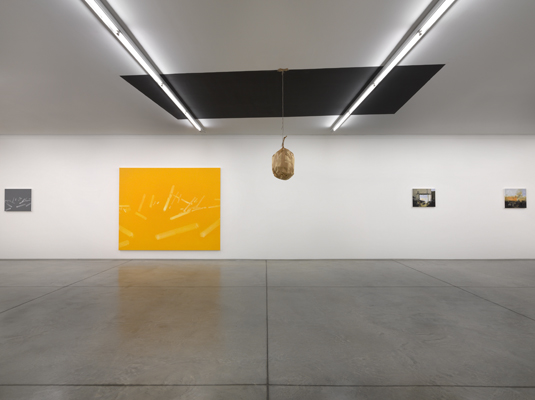GERMANIA UND ITALIA. The Continuance of the Contemporary Show press -
 Texts & Contributions / Michael van Ofen / Mario Diacono - abstract of the catalogue text Show press -
 Statement / Michael van Ofen / Michael van Ofen - statement Show press  -
 In opera / Michael van Ofen / Michael van Ofen's studio, Düsseldorf, with some artworks for the exhibition "GERMANIA UND ITALIA"
Courtesy of the artist -
 In opera / Michael van Ofen / Michael van Ofen's studio, Düsseldorf, with some artworks for the exhibition "GERMANIA UND ITALIA"
Courtesy of the artist -
 In opera / Michael van Ofen / Michael van Ofen's studio, Düsseldorf, with some artworks for the exhibition "GERMANIA UND ITALIA"
Courtesy of the artist -
 In opera / Michael van Ofen / "GERMANIA UND ITALIA"
The Campaign as Administrative Representation in: "Graf Moltke in seinem Arbeitszimmer in Versailles", 1872, 99x71 cm, 2013
oil on canvas, 200 x 150 cm -
 In opera / Michael van Ofen / "GERMANIA UND ITALIA"
Linear Emphasis of the Subject in: "Die Eroeffnung des Reichstags im Weissen Saal des Berliner Schlosses durch Wilhelm II.", 1893, 387x642 cm, 2013
oil on canvas, 200 x 230 cm -
 In opera / Michael van Ofen / "GERMANIA UND ITALIA"
Content Loss by Communication in: "Illustrative Diagram of Nicolaus Hoff after Johann Friedrich Overbeck", Germania und Italia, 1828, 2013
oil on canvas, 39 x 41 cm -
 In opera / Michael van Ofen / "GERMANIA UND ITALIA"
The Concept of the Armory in: Federico Faruffini, "La morte di Ernesto Cairoli nella Battaglia di Varese", 1862, 145x290 cm, 2013
oil on canvas, 200 x 250 cm -
 In opera / Michael van Ofen / "GERMANIA UND ITALIA"
exhibition view
Ph. C. Dario Lasagni -
 In opera / Michael van Ofen / "GERMANIA UND ITALIA"
exhibition view
Ph. C. Dario Lasagni -
 In opera / Michael van Ofen / "GERMANIA UND ITALIA"
exhibition view
Ph. C. Dario Lasagni -
 In opera / Michael van Ofen / "GERMANIA UND ITALIA"
exhibition view
Ph. C. Dario Lasagni -
 In opera / Michael van Ofen / "GERMANIA UND ITALIA"
The Duality of Everything, Sketch for a Memorial. Bismarck, Garibaldi., 2013
paper, thread and wallpaint, variable dimension
Ph. C. Dario Lasagni  Show press -
 Opening / Michael van Ofen / "GERMANIA UND ITALIA"
opening, 5 October 2013
Ph. C. Luis Aniceto / Cesura -
 Opening / Michael van Ofen / "GERMANIA UND ITALIA"
opening, 5 October 2013
Ph. C. Luis Aniceto / Cesura -
 Opening / Michael van Ofen / "GERMANIA UND ITALIA"
opening, 5 October 2013
Ph. C. Luis Aniceto / Cesura -
 Opening / Michael van Ofen / "GERMANIA UND ITALIA"
opening, 5 October 2013
the artist with some guests
Ph. C. Luis Aniceto / Cesura -
 Opening / Michael van Ofen / "GERMANIA UND ITALIA"
opening, 5 October 2013
Ph. C. Luis Aniceto / Cesura -
 Opening / Michael van Ofen / "GERMANIA UND ITALIA"
opening, 5 October 2013
Ph. C. Luis Aniceto / Cesura -
 Opening / Michael van Ofen / "GERMANIA UND ITALIA"
opening, 5 October 2013
the artist with a guest
Ph. C. Luis Aniceto / Cesura -
 Opening / Michael van Ofen / "GERMANIA UND ITALIA"
opening, 5 October 2013
Ph. C. Luis Aniceto / Cesura -
 Opening / Michael van Ofen / "GERMANIA UND ITALIA"
opening, 5 October 2013
the artist
Ph. C. Luis Aniceto / Cesura Show press -
Talk / Michael van Ofen / Michael van Ofen on his work - realized by 3D Produzioni -
Talk / Michael van Ofen / Conversation with the interns of the Peggy Guggenheim Collection -
 Exhibition image -
 Texts and contributions -
 Statement -
 In opera -
 Opening -
 Talk |
















